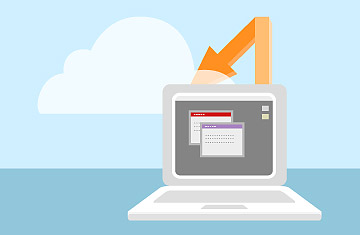
(2 of 2)
For photos and videos, Google's Picasa Web Albums service is even more tightwad-friendly: 20 GB of storage costs a measly $5 a year. And you might not even need to pay that much, since photos of less than 2048-by-2048 resolution and videos that run for less than 15 minutes don't count against your freebie allotment of 1 GB of space.
And then there's Microsoft's SkyDrive, which gives you 25 GB of Web-based space for anything, for free.
All these services have a no-frills feel compared to their pricier rivals. Cloud Drive and Picasa don't do fancy automatic synching of files of all sorts, and SkyDrive does it only for 5 GB of files, and only in conjunction with a low-profile Microsoft service called Live Mesh. But if they give you what you need, the price is certainly right.
3. Put a hard drive on the Web.
I have more than a few tech-savvy friends who instinctively bristle at the notion of entrusting their prized files to a SugarSync, a Google or anybody else. Rather than pay for the privilege of uploading data to distant servers in undisclosed locations, they prefer to keep it at home under their own supervision. Fine. It's possible to do that while also putting your files in the cloud, by using a storage device that piggybacks on your home network's Internet connection to make your content available (with password protection) on any Net-connected device.
Storage systems that do this abound, such as Western Digital's My Book World Edition and Iomega's Home Media Drive Cloud Edition. I like Buffalo's CloudStor, which starts at $159.99 for a version that packs a 1-TB hard drive. Its built-in software, powered by a clever service called PogoPlug, makes setting up the drive and reaching your files from any browser just about painless, with no knowledge of networking minutiae required. All 1 TB (or more) of disk space is up for grabs — a mammoth amount of real estate by cloud-based storage standards.
My major reservation about these gizmos is the same one that makes them appealing to many folks: they don't duplicate your files to a remote server. For priceless treasures like your best family photos, you don't just want to have a backup — you want backups of your backups. And — not to get too depressing here — it's best if some of the backups are stored somewhere other than your house, just in case disaster strikes. Unlike my more paranoid pals, I'm comfortable allowing outfits like SugarSync and Google to manage my data. They'll surely do a better job of backing everything up than I would if left to my own devices.
4. Put your computer on the Web.
Still reading? Maybe you don't care to use a fully Web-based service and don't want to invest in a networked storage device. If so, you still have options in the form of software that can put the contents of any PC on your home network onto the Internet. For instance, PogoPlug (the software I admire in Buffalo's CloudStor) is also available as a stand-alone, downloadable version for Windows and Macs. Install it on a computer and run it at all times, and it gathers up all the photos, music, videos and other files on the computer and lets you access them from any browser and from PogoPlug's apps for the iPhone, iPad and Android. As with the CloudStor version, it's about as hassle-free as networking gets, and there's a less-powerful free version.
Even more than with networked drives, it's important to remember that the PogoPlug software isn't a substitute for a backup strategy. And it requires you to leave your computer on, something that's more plausible if you own a desktop PC that stays put than if you tote a laptop.
If none of these approaches appeals to you, there's another viable strategy: wait. Even more options are on the way, the most notable of which is Apple's iCloud service. Due this fall, it aims to deliver the simplest, most comprehensive approach to storing data on the Net, at least if you're equipped with a full complement of Apple devices, such as a Mac, an iPhone, an iPod Touch, an iPad or any combination of those products. Steve Jobs, as you'd expect, says that iCloud "just works." If he's right, count me in — but until then, I'm a happy SugarSync customer.
McCracken blogs about personal technology at Technologizer, which he founded in 2008 after nearly two decades as a tech journalist; on Twitter, he's @harrymccracken. His column, also called Technologizer, appears every Thursday on TIME.com.
